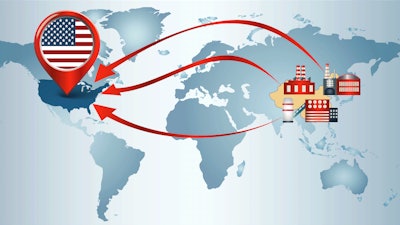
Among the latest buzzwords (or in this case, buzz terms) in the C-suite is what some are predicting to be the “Golden Era of Onshoring.” To examine this concept, it makes sense to review some history.
At the onset of WWII, our English roots primed our new economic well with an already-established and vast trading network throughout Europe. We were already producing half of the world’s industrial output and realized the benefits of onshoring at that time – yes, during another global crisis – because we had the resources and desire to become self-efficient and self-sustaining.
That trend lasted well into the 1970s, but by the end of that decade many public companies had begun to look at off-shoring to maximize profit for their shareholders. So the floodgates swung open in the other direction – leaving many domestic factories shuttered by the time the 1980s rolled around.
During the Reagan era, global trade was a boon to the global economy, giving a much-needed boost to countries who didn’t have the means to create their own self-sustaining economies. We notably did not experience a global crisis, which tended to create an “inward looking” philosophy.
The first big disruption to this period, believe it or not, was COVID-19. Of course, we’ve experienced economic effects of pandemics before. The Spanish flu between 1918 and 1920 resulted in tens of millions of deaths, yet it was proceeded by a decade of innovation. But we couldn’t get too comfortable, of course: the Great Depression was just around the corner, and with it came a great panic in the banking industry.
So here we are, nearly 100 years later. Prior to the pandemic, manufacturers were accustomed to offshore transportation time tying up cash flow, and accepted long lead times as part of the cost of a globalized economy. But due to the global pandemic dramatically increasing lead times, many companies were forced to re-examine their supply chains and find alternative solutions.
Let’s examine what a golden era of onshoring could look like, and 10 ways that manufacturers can prepare and benefit:
- Embrace it! In many ways, the past few years felt like a whirlwind. This period of time will have everlasting effects. Change is the only constant in both life and business.
- Plan and prepare now. U.S. manufacturers in virtually any sector ought to be asking how they can either produce or source domestically in one, three and five years – and starting to plan NOW! Think about components as well, either product or packaging. Any and everything that goes into a product by the time it’s shipped to your customer is eligible for domestic sourcing. Plan both in macro and micro terms. Do your homework and create a step-by step “roadmap” to onshoring.
- Land (somewhere) now. Find or expand real estate for future production. We’ve seen the corporate office space market crumble due to remote work, which certainly appears to be here to stay indefinitely. Look at investing and retooling these buildings.
- Automate now. It used to be said that location, location, and location were the three most important factors of a consumer-oriented business. Other than food and some services, this is largely no longer the case, thanks to the innovation occurring within our domestic manufacturing and distribution industries. Now, the more important keywords of a business may be automate, automate, and automate! Think smart manufacturing leading to smart product management (case erecting, case packing, palletizing), to smart warehouses and smart “just in time” distribution. Robotics are here today and can assist in every single part of your process, allowing you the ability to develop products around and complimentary to automation.
- Hire now to invest in the future. The “Great Resignation,” accompanied by a mass retirement of baby boomers and lack of skilled labor coming out of school, is leading to a workforce void. The need to hire and train around automation is critical. You don’t need people doing tasks that robotics and automation can achieve. And with a narrowing ROI, many automation components can pay for themselves within 1-2 years.
- Partner now. Build alliances with key partners who can help you navigate landmines and plan ahead. Architecture and Engineering companies like us will partner with domestic manufacturers to build modern “smart” factories that are set up to succeed and flourish for decades to come. While our firm specializes in food and beverage, many A&E companies out there in a variety of industries are available to work on your behalf and set you up for onshoring success.
- Innovate and enhance quality now. A hundred years ago we were on the cusp of one of the most remarkable decades of innovation in American history. In fact, many of the inventions from that era are still with us. Today, technological advances are said to double every 1-2 years. This stat, coupled with a pent-up need for innovation, will lead those businesses that embrace it to an increased level of defensibility. And think about how producing your own products or sourcing them domestically will increase quality, and reduce write-offs and returns. Every country has a different concept of quality, and we’d like to think the United States sets the gold standard. Consider the benefits of delivering first-rate products to your customers and the impact to your bottom line.
- Practice patience now. We’re already seeing industries like semiconductors announce massive domestic expansions. But because of their vast size, this will take time. While it’s important to look forward and have a sense of urgency around onshoring, it’s also important to be patient and not compromise quality for speed.
- Bank on a return of pride. Remember the “Made in the USA” campaign? It’s coming back with vengeance – although it may look and sound a little different. The difference this time around is that it won’t solely be a consumer-aimed campaign, but rather shared among suppliers and manufacturers.
- Profit later – investment is required up front, yes, but eventually profits will be stabilized as tariffs, customs, and duties become things of the past. Imagine a time when transportation and lead times are cut in half. Use this as motivation now to build a successful onshoring plan.
For more than 40 years, our talented WEBBER/SMITH team of Engineers and Designers has been committed to forming meaningful relationships and creating comprehensive solutions. For more information: [email protected] or (717) 625-4140.






















